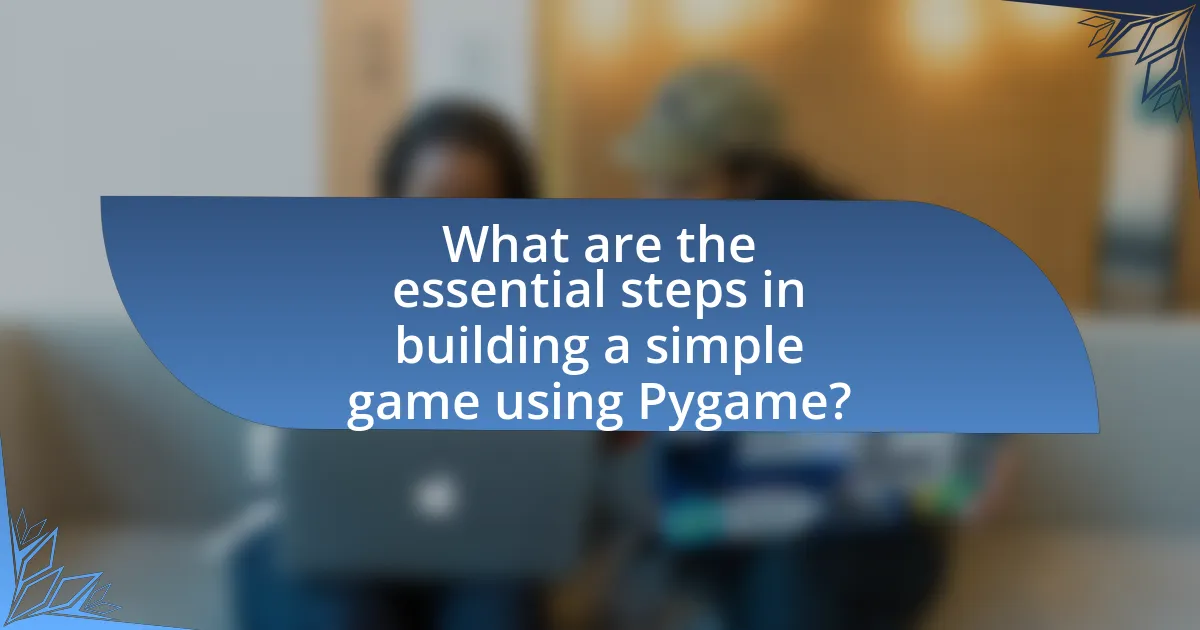Game development with Python and Pygame involves utilizing the Python programming language alongside the Pygame library to create engaging 2D video games. The article outlines how Python’s simplicity and extensive libraries facilitate game development, while Pygame provides essential tools for graphics, sound, and user input management. It discusses the advantages of using Python for game development, the types of games that can be created with Pygame, and the essential steps for building a simple game. Additionally, it addresses common challenges faced by developers, best practices for optimizing performance, and available resources for further learning.

What is Game Development with Python and Pygame?
Game development with Python and Pygame involves creating video games using the Python programming language in conjunction with the Pygame library. Pygame provides tools and functionalities for handling graphics, sound, and user input, making it easier for developers to build 2D games. The library is widely recognized for its simplicity and accessibility, allowing both beginners and experienced programmers to create games efficiently. According to the official Pygame documentation, it supports various multimedia features, which are essential for game development, thus validating its effectiveness as a game development framework.
How does Python facilitate game development?
Python facilitates game development through its simplicity and readability, which allows developers to write code quickly and efficiently. The language’s extensive libraries, such as Pygame, provide pre-built functions for graphics, sound, and input handling, significantly reducing the time required to develop games. Additionally, Python’s cross-platform compatibility enables games to run on various operating systems without major modifications, enhancing accessibility for developers and players alike. The active community and wealth of resources available for Python further support game development by offering tutorials, forums, and documentation, making it easier for both beginners and experienced developers to create engaging games.
What are the advantages of using Python for game development?
Python offers several advantages for game development, including simplicity, readability, and a rich ecosystem of libraries. Its syntax is straightforward, allowing developers to write code quickly and efficiently, which is particularly beneficial for prototyping and iterative development. Additionally, Python has powerful libraries such as Pygame, which simplifies the process of creating games by providing tools for graphics, sound, and input handling. The language’s extensive community support and resources further enhance its usability, making it easier for developers to find solutions and share knowledge. These factors contribute to Python’s growing popularity in the game development industry.
What role does Pygame play in Python game development?
Pygame serves as a crucial library for Python game development by providing essential tools and functionalities for creating games. It simplifies the process of game development by offering modules for graphics, sound, and input handling, which allows developers to focus on game design rather than low-level programming details. Pygame supports 2D graphics rendering, event handling, and multimedia integration, making it a comprehensive framework for building interactive games. Its widespread use is evidenced by a large community and extensive documentation, which further facilitates learning and development for both beginners and experienced programmers.
What types of games can be developed using Pygame?
Pygame can be used to develop a variety of games, including 2D platformers, puzzle games, arcade games, and educational games. The library provides functionalities for graphics, sound, and input handling, making it suitable for creating engaging gameplay experiences. For instance, many developers have successfully created classic arcade-style games like Space Invaders and platformers similar to Super Mario using Pygame, demonstrating its versatility in game development.
What are the characteristics of 2D games created with Pygame?
2D games created with Pygame typically feature simple graphics, straightforward gameplay mechanics, and a focus on 2D sprite-based animations. These games often utilize a grid-based or pixel-based design, allowing for easy manipulation of game objects and environments. Pygame supports various multimedia elements, enabling sound effects and music integration, which enhances the gaming experience. Additionally, Pygame provides built-in functions for handling user input, collision detection, and game loops, making it accessible for beginners in game development. The library’s flexibility allows developers to create diverse genres, from platformers to puzzle games, while maintaining a lightweight framework suitable for rapid prototyping.
How can Pygame be used to create educational games?
Pygame can be used to create educational games by providing a framework that simplifies game development, allowing developers to focus on educational content. This library offers functionalities such as graphics rendering, sound playback, and user input handling, which are essential for interactive learning experiences. For instance, developers can design games that teach math concepts through puzzles or language skills through word games, leveraging Pygame’s capabilities to create engaging and interactive environments. Additionally, Pygame supports various multimedia formats, enabling the integration of animations and audio that enhance the educational value of the games.

What are the essential steps in building a simple game using Pygame?
The essential steps in building a simple game using Pygame include setting up the Pygame library, creating the game window, implementing the game loop, handling user input, updating game logic, rendering graphics, and managing game events. First, install Pygame and import it into your Python script. Next, initialize Pygame and create a display window with specified dimensions. The game loop is crucial as it continuously checks for events, updates game states, and redraws the screen. User input can be captured through keyboard or mouse events, which influence game behavior. Updating game logic involves modifying object positions or states based on user input or game rules. Rendering graphics entails drawing game elements on the screen, such as characters and backgrounds. Finally, manage events like quitting the game to ensure smooth operation. These steps are foundational for developing a functional game using Pygame.
How do you set up the Pygame environment?
To set up the Pygame environment, first install Python, ensuring it is version 3.6 or higher. Next, use the command “pip install pygame” in the terminal or command prompt to install the Pygame library. This installation process is validated by the official Pygame documentation, which confirms that Pygame is compatible with Python 3 and provides installation instructions. After installation, verify the setup by running a simple Pygame script to check for successful execution.
What are the system requirements for installing Pygame?
Pygame requires a system with Python 3.6 or higher installed, along with a compatible operating system such as Windows, macOS, or Linux. Additionally, users should have a minimum of 1 GB of RAM and a graphics card that supports OpenGL 2.0 or higher for optimal performance. These requirements ensure that Pygame can run effectively and support its graphical capabilities.
How do you install Pygame on different operating systems?
To install Pygame on different operating systems, use the following methods:
For Windows, open Command Prompt and run the command “pip install pygame”. This command utilizes Python’s package manager, pip, to download and install Pygame directly from the Python Package Index (PyPI).
For macOS, open Terminal and execute the same command “pip install pygame”. This will also fetch Pygame from PyPI, ensuring compatibility with macOS.
For Linux, the installation can vary slightly depending on the distribution. Generally, you can use the command “pip install pygame” in the terminal. Some distributions may require additional dependencies to be installed beforehand, which can be done using the package manager specific to the distribution.
These methods are validated by the official Pygame documentation, which confirms that pip is the recommended installation method across all major operating systems.
What are the key components of a simple game in Pygame?
The key components of a simple game in Pygame include the game loop, event handling, game state management, rendering graphics, and updating game logic. The game loop continuously runs to keep the game active, while event handling processes user inputs such as keyboard and mouse actions. Game state management tracks the current status of the game, such as whether the player is in a menu or actively playing. Rendering graphics involves drawing images and shapes on the screen to represent game elements, and updating game logic modifies the state of the game based on player actions and game rules. These components work together to create an interactive gaming experience.
How do you create a game window in Pygame?
To create a game window in Pygame, you initialize Pygame and then use the pygame.display.set_mode() function. This function takes a tuple representing the width and height of the window, for example, pygame.display.set_mode((800, 600)) creates a window of 800 pixels wide and 600 pixels high. After setting the mode, you can set the window title using pygame.display.set_caption("Your Game Title"). This method is validated by the Pygame documentation, which specifies that set_mode() is essential for creating a display surface where the game will be rendered.
What are sprites and how are they used in Pygame?
Sprites are objects that represent characters, items, or other entities in a game, used in Pygame to facilitate the management and rendering of these graphical elements. In Pygame, sprites are implemented through the Sprite class, which allows developers to group related images and handle their behavior, such as movement and collision detection, efficiently. The Pygame library provides a Sprite Group class that enables batch processing of multiple sprites, optimizing rendering and updates during the game loop. This structured approach enhances performance and simplifies code management, making it easier for developers to create interactive and visually appealing games.

What are common challenges faced in Pygame development?
Common challenges faced in Pygame development include performance issues, difficulty in managing game states, and handling user input effectively. Performance issues often arise due to inefficient rendering and resource management, which can lead to lag or frame drops, especially in more complex games. Managing game states, such as transitions between menus, gameplay, and pause screens, can become cumbersome without a clear structure, leading to bugs and a poor user experience. Additionally, handling user input can be challenging, as developers must account for various input devices and ensure responsive controls, which can complicate the development process.
How can you troubleshoot common issues in Pygame?
To troubleshoot common issues in Pygame, first identify the specific error message or behavior occurring in your game. Common issues include problems with initialization, display, or event handling. For instance, if the window does not appear, ensure that Pygame is initialized correctly using pygame.init() and that the display is set up with pygame.display.set_mode(). If the game runs but does not respond to input, check the event loop to ensure it processes events correctly. Additionally, reviewing the Pygame documentation can provide insights into specific functions and their expected behavior, which can help resolve issues effectively.
What are the most frequent errors encountered by beginners?
The most frequent errors encountered by beginners in game development with Python using Pygame include syntax errors, incorrect use of Pygame functions, and failure to manage game loops effectively. Syntax errors often arise from typos or incorrect indentation, which can prevent the code from running. Beginners frequently misuse Pygame functions, such as not initializing Pygame properly or misunderstanding how to handle events, leading to unexpected behavior. Additionally, many beginners struggle with managing the game loop, resulting in performance issues or unresponsive games. These errors are common due to the learning curve associated with programming and game development concepts.
How can you optimize game performance in Pygame?
To optimize game performance in Pygame, developers should focus on reducing the number of drawn objects and minimizing calculations per frame. This can be achieved by using sprite groups to manage multiple sprites efficiently, which reduces the overhead of individual draw calls. Additionally, implementing double buffering can help prevent flickering and improve rendering speed by drawing to an off-screen surface before displaying it. Profiling the game using tools like Pygame’s built-in clock can identify performance bottlenecks, allowing developers to target specific areas for optimization. Furthermore, limiting the frame rate to a manageable level, such as 60 frames per second, can help maintain consistent performance across different hardware.
What best practices should be followed when developing games with Pygame?
When developing games with Pygame, it is essential to follow best practices such as organizing code into functions and classes, optimizing performance, and managing resources effectively. Organizing code improves readability and maintainability, allowing developers to easily navigate and update their projects. Performance optimization can be achieved by minimizing the use of heavy computations within the game loop and utilizing Pygame’s built-in functions for rendering and event handling. Effective resource management involves loading assets like images and sounds only once and reusing them throughout the game, which reduces memory usage and loading times. These practices enhance the overall quality and efficiency of the game development process in Pygame.
How can you structure your code for better maintainability?
To structure your code for better maintainability in game development with Python using Pygame, implement a modular architecture by organizing code into distinct, reusable components. This approach allows for easier updates and debugging, as each module can be modified independently without affecting the entire codebase. For instance, separating game logic, rendering, and input handling into different files enhances clarity and reduces complexity. Additionally, adhering to the DRY (Don’t Repeat Yourself) principle minimizes redundancy, making the codebase cleaner and more efficient. Research indicates that modular code can reduce maintenance costs by up to 40%, highlighting its effectiveness in long-term project sustainability.
What resources are available for learning more about Pygame?
The primary resources available for learning more about Pygame include the official Pygame documentation, online tutorials, and community forums. The official documentation provides comprehensive guides and examples, making it a foundational resource for understanding Pygame’s functionalities. Websites like Real Python and freeCodeCamp offer step-by-step tutorials that cater to various skill levels, enhancing practical learning. Additionally, community forums such as Stack Overflow and the Pygame subreddit allow users to ask questions and share knowledge, fostering a collaborative learning environment. These resources collectively support learners in mastering Pygame for game development.
What tips can enhance your game development experience with Pygame?
To enhance your game development experience with Pygame, focus on mastering the library’s core functionalities and utilizing its community resources. Understanding Pygame’s event handling, graphics rendering, and sound management will allow for smoother game mechanics and better performance. Engaging with the Pygame community through forums and tutorials can provide valuable insights and troubleshooting tips, as many developers share their experiences and solutions to common problems. Additionally, leveraging Pygame’s built-in functions and optimizing your code for efficiency can significantly improve your game’s responsiveness and user experience.


